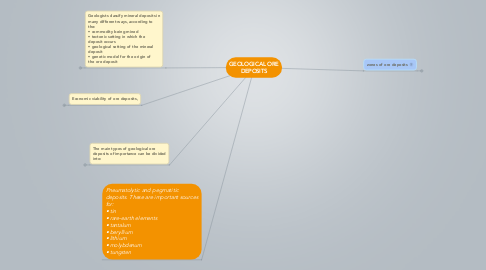
1. Pneumatolytic and pegmatitic deposits. These are important sources for: • tin • rare-earth elements • tantalum • beryllium • lithium • molybdenum • tungsten
2. Geologists classify mineral deposits in many different ways, according to the: • commodity being mined • tectonic setting in which the deposit occurs • geological setting of the mineral deposit • genetic model for the origin of the ore deposit
2.1. Orthomagmatic deposits include: • chromium • titanium • iron • nickel • copper • platinum-group elements • diamonds
2.2. Archaean gold deposits
2.2.1. Archaean gold deposits account for more than 60% of the world's gold
2.3. Epithermal gold deposits
2.3.1. • native gold and silver • electrum • acanthite and tetrahedrite • silica occurring as quartz (most often forming comb-like aggregates), amethyst, opal, chalcedony and cristobalite
2.4. Sedimentary iron ore and manganese deposits
2.5. Placer deposits
2.5.1. The most common placer deposits are those of gold, platinum, group minerals, gemstones, tin, rutile, monazite and zircon.
2.6. Clay deposits
2.6.1. China Clay Fullers Earth
2.7. Evaporite deposits
2.7.1. An ideal evaporite sequence (in decreasing order of solubility) is as follows: • Potassium and magnesium salts (kainite, carnallite, sylvite) type 1 • Rock salt (halite) - type 2 • Gypsum (below 42° C) or anhydrite (above 42° C) - type 3 • Calcite and dolomite - type 4
2.8. Phosphatic deposits
2.8.1. 1. Primary marine phosphate deposits
2.8.2. 2. Bone beds
2.8.3. 3. Guano
2.9. Organic deposits
2.9.1. Coal
2.9.1.1. • Peat • Lignite (also known as brown coal) • Sub-bituminous coal • Bituminous coal • Sub-anthracite • Anthracite
2.9.2. Fireclay
2.9.2.1. Fireclay is a fossil clay-rich soil associated with coal deposits. It is useful as a refractory material.
2.9.3. Peat
2.9.3.1. Peat deposits have long been used (particularly in Northern Europe) as a source of fuel.
2.9.4. Oil/petroleum
2.9.4.1. • Kerogen: a solid organic material that yields petroleum-type hydrocarbons on heating and distillation. • Tar pits: small areas where soft asphaltic tar wells up to the surface and fills a hollow. • Oil shale: this is a fine-grained black or dark grey clay-rich sedimentary rock that yields liquid hydrocarbons upon distillation (i.e. heating). Most oil shale deposits are associated with coal.
2.10. Residual deposits
2.10.1. Residual deposits are formed in tropical regions
3. zones of ore deposits
3.1. Oxidised zones of ore deposits. The most common minerals found in oxidised zones are:
3.1.1. • Copper: malachite, azurite, chrysocolla • Gangue minerals: quartz (usually cryptocrystalline), baryte, calcite, aragonite • Iron: goethite, hematite • Lead: anglesite, cerussite • Manganese: pyrolusite, romanechite, rhodochrosite • Nickel: gaspeite, garnierite • Silver: native silver, chlorargyrite • Zinc: smithsonite
